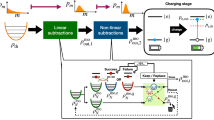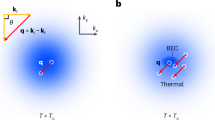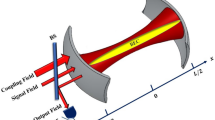Abstract
Strong and precisely controlled interactions between quantum objects are essential for quantum information processing1,2, simulation3 and sensing4,5, and for the formation of exotic quantum matter6. A well-established paradigm for coupling otherwise weakly interacting quantum objects is to use auxiliary bosonic quantum excitations to mediate the interactions. Important examples include photon-mediated interactions between atoms7, superconducting qubits8, and colour centres in diamond9, and phonon-mediated interactions between trapped ions10,11,12 and between optical and microwave photons13. Boson-mediated interactions can, in principle, be amplified through parametric driving of the boson channel; the drive need not couple directly to the interacting quantum objects. This technique has been proposed for a variety of quantum platforms14,15,16,17,18,19,20,21,22,23,24, but has not, so far, been realized in the laboratory. Here we experimentally demonstrate the amplification of a boson-mediated interaction between two trapped-ion qubits by parametric modulation of the trapping potential21. The amplification provides up to a 3.25-fold increase in the interaction strength, validated by measuring the speed-up of two-qubit entangling gates. This amplification technique can be used in any quantum platform where parametric modulation of the boson channel is possible, enabling exploration of new parameter regimes and enhanced quantum information processing.
This is a preview of subscription content, access via your institution
Access options
Access Nature and 54 other Nature Portfolio journals
Get Nature+, our best-value online-access subscription
$29.99 / 30 days
cancel any time
Subscribe to this journal
Receive 12 print issues and online access
$209.00 per year
only $17.42 per issue
Buy this article
- Purchase on Springer Link
- Instant access to full article PDF
Prices may be subject to local taxes which are calculated during checkout



Similar content being viewed by others
Data availability
Source data are provided with this paper. All other data that support the plots within this paper and other findings of this study are available from the corresponding authors upon reasonable request.
Code availability
The simulation and analysis codes are available from the corresponding authors upon reasonable request.
References
Bruzewicz, C. D., Chiaverini, J., McConnell, R. & Sage, J. M. Trapped-ion quantum computing: progress and challenges. Appl. Phys. Rev. 6, 021314 (2019).
Blais, A., Girvin, S. M. & Oliver, W. D. Quantum information processing and quantum optics with circuit quantum electrodynamics. Nat. Phys. 16, 247–256 (2020).
Georgescu, I. M., Ashhab, S. & Nori, F. Quantum simulation. Rev. Mod. Phys. 86, 153–185 (2014).
Degen, C. L., Reinhard, F. & Cappellaro, P. Quantum sensing. Rev. Mod. Phys. 89, 035002 (2017).
Pezzè, L., Smerzi, A., Oberthaler, M. K., Schmied, R. & Treutlein, P. Quantum metrology with nonclassical states of atomic ensembles. Rev. Mod. Phys. 90, 035005 (2018).
Bloch, I., Dalibard, J. & Zwerger, W. Many-body physics with ultracold gases. Rev. Mod. Phys. 80, 885–964 (2008).
Gerry, C. C. & Knight, P. L. Introductory Quantum Optics (Cambridge Univ. Press, 2005).
Blais, A., Huang, R.-S., Wallraff, A., Girvin, S. M. & Schoelkopf, R. J. Cavity quantum electrodynamics for superconducting electrical circuits: an architecture for quantum computation. Phys. Rev. A 69, 062320 (2004).
Evans, R. E. et al. Photon-mediated interactions between quantum emitters in a diamond nanocavity. Science 362, 662–665 (2018).
Cirac, J. I. & Zoller, P. Quantum computations with cold trapped ions. Phys. Rev. Lett. 74, 4091–4094 (1995).
Sørensen, A. & Mølmer, K. Quantum computation with ions in thermal motion. Phys. Rev. Lett. 82, 1971–1974 (1999).
Milburn, G. J., Schneider, S. & James, D. F. V. Ion trap quantum computing with warm ions. Fortschr. Phys. 48, 801–810 (2000).
Higginbotham, A. P. et al. Harnessing electro-optic correlations in an efficient mechanical converter. Nat. Phys. 14, 1038–1042 (2018).
Lü, X.-Y. et al. Squeezed optomechanics with phase-matched amplification and dissipation. Phys. Rev. Lett. 114, 093602 (2015).
Lemonde, M.-A., Didier, N. & Clerk, A. A. Enhanced nonlinear interactions in quantum optomechanics via mechanical amplification. Nat. Commun. 7, 11338 (2016).
Zeytinoğlu, S., İmamoğlu, A. & Huber, S. Engineering matter interactions using squeezed vacuum. Phys. Rev. X 7, 021041 (2017).
Qin, W. et al. Exponentially enhanced light-matter interaction, cooperativities, and steady-state entanglement using parametric amplification. Phys. Rev. Lett. 120, 093601 (2018).
Chen, Y.-H., Qin, W. & Nori, F. Fast and high-fidelity generation of steady-state entanglement using pulse modulation and parametric amplification. Phys. Rev. A 100, 012339 (2019).
Leroux, C., Govia, L. C. G. & Clerk, A. A. Enhancing cavity quantum electrodynamics via antisqueezing: synthetic ultrastrong coupling. Phys. Rev. Lett. 120, 093602 (2018).
Arenz, C., Bondar, D. I., Burgarth, D., Cormick, C. & Rabitz, H. Amplification of quadratic Hamiltonians. Quantum 4, 271 (2020).
Ge, W. et al. Trapped ion quantum information processing with squeezed phonons. Phys. Rev. Lett. 122, 030501 (2019).
Ge, W. et al. Stroboscopic approach to trapped-ion quantum information processing with squeezed phonons. Phys. Rev. A 100, 043417 (2019).
Groszkowski, P., Lau, H.-K., Leroux, C., Govia, L. C. G. & Clerk, A. A. Heisenberg-limited spin squeezing via bosonic parametric driving. Phys. Rev. Lett. 125, 203601 (2020).
Li, P.-B., Zhou, Y., Gao, W.-B. & Nori, F. Enhancing spin-phonon and spin-spin interactions using linear resources in a hybrid quantum system. Phys. Rev. Lett. 125, 153602 (2020).
Ballance, C. J., Harty, T. P., Linke, N. M., Sepiol, M. A. & Lucas, D. M. High-fidelity quantum logic gates using trapped-ion hyperfine qubits. Phys. Rev. Lett. 117, 060504 (2016).
Gaebler, J. P. et al. High-fidelity universal gate set for 9Be+ ion qubits. Phys. Rev. Lett. 117, 060505 (2016).
McKay, D. C., Sheldon, S., Smolin, J. A., Chow, J. M. & Gambetta, J. M. Three-qubit randomized benchmarking. Phys. Rev. Lett. 122, 200502 (2019).
Meyer, V. et al. Experimental demonstration of entanglement-enhanced rotation angle estimation using trapped ions. Phys. Rev. Lett. 86, 5870–5873 (2001).
Cox, K. C., Greve, G. P., Weiner, J. M. & Thompson, J. K. Deterministic squeezed states with collective measurements and feedback. Phys. Rev. Lett. 116, 093602 (2016).
Hosten, O., Engelsen, N. J., Krishnakumar, R. & Kasevich, M. A. Measurement noise 100 times lower than the quantum-projection limit using entangled atoms. Nature 529, 505–508 (2016).
Bohnet, J. G. et al. Quantum spin dynamics and entanglement generation with hundreds of trapped ions. Science 352, 1297–1301 (2016).
Mottl, R. et al. Roton-type mode softening in a quantum gas with cavity-mediated long-range interactions. Science 336, 1570–1573 (2012).
Léonard, J., Morales, A., Zupancic, P., Esslinger, T. & Donner, T. Supersolid formation in a quantum gas breaking a continuous translational symmetry. Nature 543, 87–90 (2017).
Ozeri, R. et al. Errors in trapped-ion quantum gates due to spontaneous photon scattering. Phys. Rev. A 75, 042329 (2007).
Sackett, C. A. et al. Experimental entanglement of four particles. Nature 404, 256–259 (2000).
Leibfried, D. et al. Experimental demonstration of a robust, high-fidelity geometric two ion-qubit phase gate. Nature 422, 412–415 (2003).
Tavis, M. & Cummings, F. W. Exact solution for an n-molecule—radiation-field Hamiltonian. Phys. Rev. 170, 379–384 (1968).
Mølmer, K. & Sørensen, A. Multiparticle entanglement of hot trapped ions. Phys. Rev. Lett. 82, 1835–1838 (1999).
Bogoljubov, N. N. On a new method in the theory of superconductivity. Nuovo Cimento 7, 794–805 (1958).
Burd, S. C. et al. Quantum amplification of mechanical oscillator motion. Science 364, 1163–1165 (2019).
Seidelin, S. et al. Microfabricated surface-electrode ion trap for scalable quantum information processing. Phys. Rev. Lett. 96, 253003 (2006).
Srinivas, R. et al. Trapped-ion spin-motion coupling with microwaves and a near-motional oscillating magnetic field gradient. Phys. Rev. Lett. 122, 163201 (2019).
Monroe, C. et al. Resolved-sideband Raman cooling of a bound atom to the 3D zero-point energy. Phys. Rev. Lett. 75, 4011–4014 (1995).
Ospelkaus, C. et al. Trapped-ion quantum logic gates based on oscillating magnetic fields. Phys. Rev. Lett. 101, 090502 (2008).
Ospelkaus, C. et al. Microwave quantum logic gates for trapped ions. Nature 476, 181–184 (2011).
Keith, A. C., Baldwin, C. H., Glancy, S. & Knill, E. Joint quantum-state and measurement tomography with incomplete measurements. Phys. Rev. A 98, 042318 (2018).
Uys, H. et al. Decoherence due to elastic Rayleigh scattering. Phys. Rev. Lett. 105, 200401 (2010).
Sørensen, A. & Mølmer, K. Entanglement and quantum computation with ions in thermal motion. Phys. Rev. A 62, 022311 (2000).
Haddadfarshi, F. & Mintert, F. High fidelity quantum gates of trapped ions in the presence of motional heating. New J. Phys. 18, 123007 (2016).
Webb, A. E. et al. Resilient entangling gates for trapped ions. Phys. Rev. Lett. 121, 180501 (2018).
Shapira, Y., Shaniv, R., Manovitz, T., Akerman, N. & Ozeri, R. Robust entanglement gates for trapped-ion qubits. Phys. Rev. Lett. 121, 180502 (2018).
Zarantonello, G. et al. Robust and resource-efficient microwave near-field entangling 9Be+ gate. Phys. Rev. Lett. 123, 260503 (2019).
Sutherland, R. T. et al. Laser-free trapped-ion entangling gates with simultaneous insensitivity to qubit and motional decoherence. Phys. Rev. A 101, 042334 (2020).
Wineland, D. J. et al. Experimental issues in coherent quantum-state manipulation of trapped atomic ions. J. Res. Natl Inst. Stand. Technol. 103, 259–328 (1998).
Heinzen, D. J. & Wineland, D. J. Quantum-limited cooling and detection of radio-frequency oscillations by laser-cooled ions. Phys. Rev. A 42, 2977–2994 (1990).
Walls, D. F. & Milburn, G. J. Quantum Optics (Springer-Verlag, 1994).
Tellinghuisen, J. Statistical error propagation. J. Phys. Chem. A 105, 3917–3921 (2001).
Turchette, Q. A. et al. Decoherence and decay of motional quantum states of a trapped atom coupled to engineered reservoirs. Phys. Rev. A 62, 053807 (2000).
Brownnutt, M., Kumph, M., Rabl, P. & Blatt, R. Ion-trap measurements of electric-field noise near surfaces. Rev. Mod. Phys. 87, 1419–1482 (2015).
Gardiner, C. W., Parkins, A. S. & Zoller, P. Wave-function quantum stochastic differential equations and quantum-jump simulation methods. Phys. Rev. A 46, 4363–4381 (1992).
Sepiol, M. A High-Fidelity Microwave Driven Two-Qubit Quantum Logic Gate in 43Ca+. PhD thesis, Univ. Oxford (2016).
Acknowledgements
We thank R. W. Simmonds, J. Schmidt and L. J. Stephenson for a careful reading of the manuscript. These experiments were performed using the ARTIQ control system. At the time the work was performed, S.C.B., R.S., H.M.K. and D.T.C.A. were Associates in the Professional Research Experience Program (PREP) operated jointly by NIST and the University of Colorado. This work was supported by the NIST Quantum Information Program.
Author information
Authors and Affiliations
Contributions
S.C.B. carried out the experiments with assistance from D.H.S., R.S., H.M.K. and D.T.C.A., based on protocols developed by W.G. and J.J.B. D.T.C.A., D.H.S., R.S., S.C.B. and H.M.K. built and maintained the apparatus. S.C.B., H.M.K., W.G. and D.H.S. analysed the data and performed simulations. S.C.B. wrote the manuscript with input from all authors. D.H.S. supervised the work, with support from J.J.B., D.T.C.A., D.L., A.C.W. and D.J.W.
Corresponding authors
Ethics declarations
Competing interests
The authors declare no competing interests.
Additional information
Peer review information Nature Physics thanks the anonymous reviewers for their contribution to the peer review of this work.
Publisher’s note Springer Nature remains neutral with regard to jurisdictional claims in published maps and institutional affiliations.
Extended data
Extended Data Fig. 1 Data and fitting to determine \({\tilde{t}}_{I,est}\).
Fidelity as a function of \(\delta ^{\prime} /2\pi\) for various values of tI for a calibrated value of the parametric coupling strength of g/2π = 49.7(6) kHz. Data points are fidelities obtained using the method described in ref. 46. Vertical error bars indicate 68% confidence intervals for the fidelity. Horizontal error bars indicate 68% confidence intervals for \(\delta ^{\prime} /2\pi\) calculated from error propagation of the measured uncertainties in δ and g within a given experiment. Red curves are slices of the 2D quadratic fitting function at the corresponding interaction times.
Source data
Source Data Fig. 2
Data for all plots.
Source Data Fig. 3
Data for all plots.
Source Data Extended Data Fig. 1
Data for all plots.
Rights and permissions
About this article
Cite this article
Burd, S.C., Srinivas, R., Knaack, H.M. et al. Quantum amplification of boson-mediated interactions. Nat. Phys. 17, 898–902 (2021). https://doi.org/10.1038/s41567-021-01237-9
Received:
Accepted:
Published:
Issue Date:
DOI: https://doi.org/10.1038/s41567-021-01237-9
This article is cited by
-
Demonstration of three- and four-body interactions between trapped-ion spins
Nature Physics (2023)
-
Robust oscillator-mediated phase gates driven by low-intensity pulses
Communications Physics (2023)
-
Squeezing for cosmic symphony
AAPPS Bulletin (2023)
-
Squeezed quantum hybrid system: Giant enhancement of magnon-phonon-spin interactions
Science China Physics, Mechanics & Astronomy (2023)
-
Quantum parametric amplification of phonon-mediated magnon-spin interaction
Science China Physics, Mechanics & Astronomy (2023)



